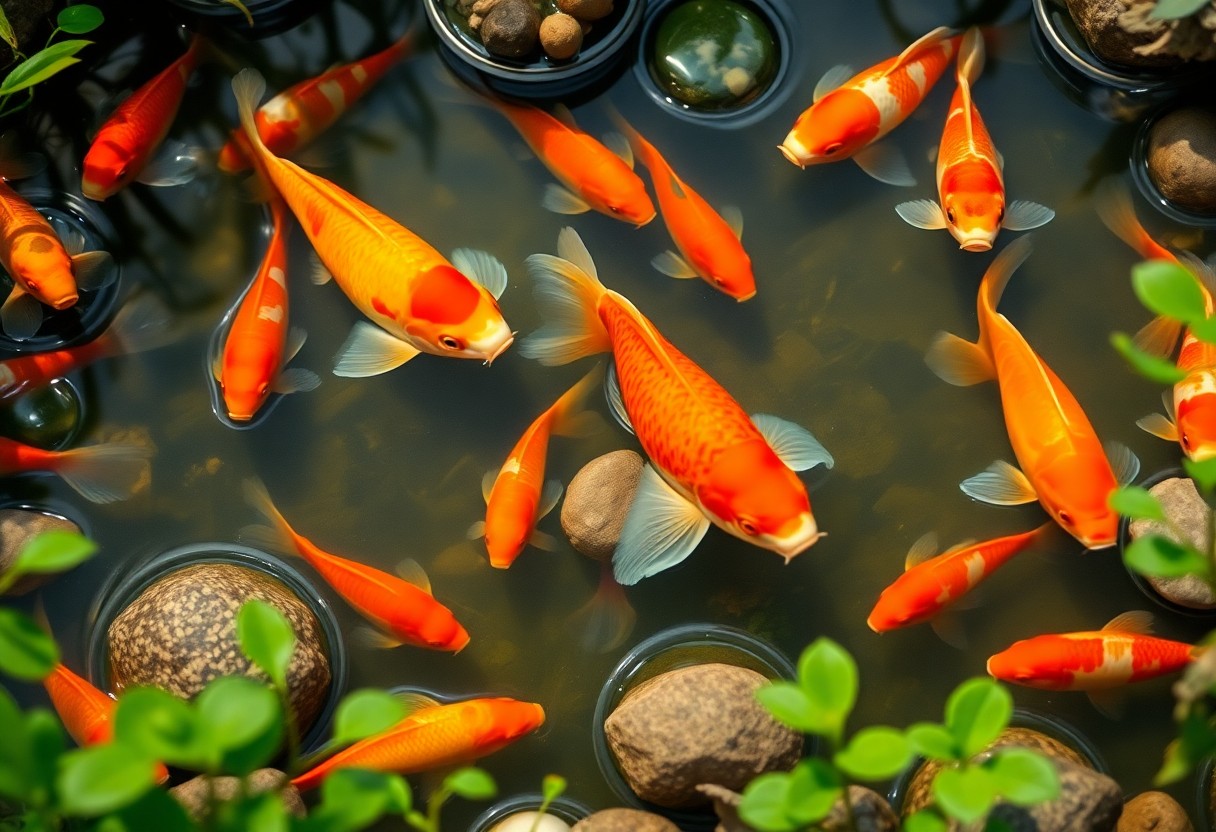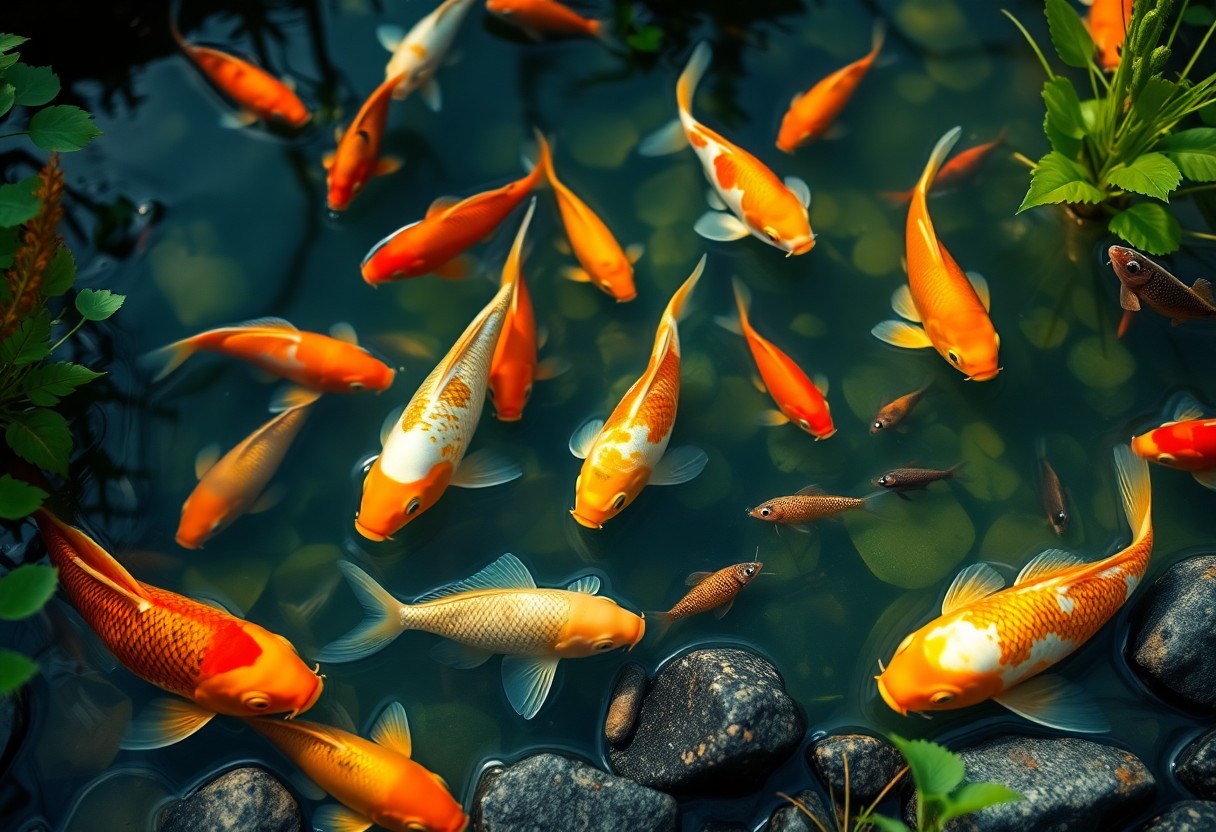Breeding habits in pond fish can vary significantly, leaving you to wonder why some species produce eggs more frequently than others. Factors such as water temperature, diet, and species-specific behaviors play pivotal roles in egg-laying frequency. Understanding these elements can greatly enhance your aquarium management techniques and ensure the health of your fish. By examining your pond conditions and fish types, you can foster an environment that promotes successful breeding, potentially leading to a thriving aquatic ecosystem.
Table of Contents
Key Takeaways:
- The frequency of egg-laying in pond fish can be influenced by species-specific reproductive behaviors and biological factors.
- Environmental conditions, such as water temperature, quality, and available space, play a significant role in triggering spawning events.
- Nutrition, particularly the availability of high-energy foods, can impact the health of fish and their reproductive patterns.
- Age and maturity levels also affect the frequency of egg production, as younger fish may not spawn as often as older, more established adults.
- Interactions with other fish and population density can lead to variations in spawning frequency due to competition or social dynamics.
Biological Factors
While the frequency of egg-laying in pond fish can vary significantly, several biological factors play a key role. These include:
- Genetics – Different breeds have unique reproductive characteristics.
- Hormonal Balance – Hormone levels dictate egg production cycles.
- Health Status – Fish in optimal health often reproduce more successfully.
Recognizing these factors can help you understand why some species produce more eggs than others.
Reproductive Maturity and Age
Across various fish species, the stage of reproductive maturity and the age of the fish significantly influence their breeding patterns. Younger fish typically take longer to reach maturity, while older fish might breed more frequently due to their experience and established conditions.
Species-Specific Breeding Cycles
To comprehend your pond fish’s spawning behaviors, understanding species-specific breeding cycles is vital. Different fish species have evolved distinct reproductive strategies that dictate when and how often they lay eggs.
But these breeding cycles can be influenced by various factors, including environmental conditions, water temperature, and the availability of resources. For example, some fish might spawn in the spring when temperatures rise, while others may breed during different seasons. This timing is often linked to survival rates of the offspring, maximizing the chances of their survival. Understanding these cycles can provide you with insights on how to best care for your fish and optimize their spawning success.
Environmental Influences
Some factors can significantly affect the frequency of egg-laying among pond fish. These environmental influences include water quality, temperature, and food availability. Understanding these elements helps you optimize your pond’s ecosystem for breeding and growth.
Water Temperature and Seasonality
Along with other factors, water temperature and seasonal changes play a significant role in reproductive cycles. The following table summarizes key effects:
Impact of Water Temperature and Seasonality
| Water Temperature | Reproductive Impact |
|---|---|
| Warm (70-75°F) | Increased egg-laying activity |
| Cold (below 60°F) | Reduced or halted spawning |
| Seasonal Changes | Triggers reproductive behaviors |
Food Availability and Nutrition
Availability of food resources directly influences egg-laying behavior in pond fish. When fish have access to a balanced diet rich in nutrients, they are more likely to reproduce.
Environmental aspects like water quality and habitat structure also play roles in food availability. A diverse diet, including live foods, helps enhance their health and vitality. Fertilizers or supplements can improve the productivity of your pond, leading to an abundance of natural food sources. When fish are well-nourished, they exhibit enhanced reproductive behaviors, increasing the likelihood of frequent spawning.
Evolutionary Adaptations
To understand why some pond fish lay eggs more frequently than others, you must consider their evolutionary adaptations. Fish species have developed unique reproductive strategies that align with their environments, ensuring optimal survival of their young. For instance, species in predator-rich areas may produce more eggs to counteract the higher mortality rates, while those in safer habitats may invest more in fewer eggs, promoting quality over quantity.
Survival Strategies
For many fish, reproductive strategies are framed around survival. Fish that can lay more eggs have the potential to offset higher predation rates, increasing the odds that some offspring will survive. In this way, frequent egg-laying can be seen as a direct response to the challenges posed by their ecosystem.
Predation Pressure
With predation pressure being a significant factor affecting reproductive behavior, fish species often adapt their breeding strategies accordingly. You may notice that fish in high-predation environments tend to spawn more frequently, as this increases the number of viable offspring. Additionally, laying eggs in safe, concealed locations can enhance the survival chances of their young.
Adaptations to predation pressure involve various behavioral and physiological traits. For example, if you look closely, you might find that some fish develop camouflage or parental care behaviors to protect their young from predators. Others may exhibit increased spawning frequency to multiply the chances of egg survival. By adapting to their surroundings, these fish enhance their reproductive success, making it imperative to understand these behaviors when observing fish populations in your local pond.
Hormonal Regulation
Unlike many terrestrial animals, pond fish rely heavily on hormonal regulation for their reproductive cycles. The interplay of hormones such as gonadotropins and sex steroids dictates not only when fish will lay eggs but also the quantity and quality of those eggs. Variations in these hormone levels can impact reproductive frequency, making some fish species more prolific than others.
Reproductive Hormones
Beside environmental factors, reproductive hormones play a significant role in the spawning behavior of pond fish. Hormones such as estradiol and testosterone are integral to the development of gametes and influence breeding activities. These hormones fluctuate with seasons or during certain events, aligning with the optimal conditions for reproduction.
Environmental Hormone Triggers
Between the myriad factors influencing pond fish reproduction, environmental hormones trigger specific reproductive behaviors. Seasonal temperature changes, water quality, and even light cycles can cause the release of hormones that stimulate spawning activities in fish. These interactions play a vital role in ensuring the survival of the species.
It is vital for you to understand that seasonal temperature changes, the quality of water, and light exposure significantly affect hormone release in pond fish. When conditions are ideal, the shift in environmental factors sends signals to the fish’s endocrine system, triggering the production of reproductive hormones. This hormonal surge encourages spawning, resulting in a higher frequency of egg-laying. Conversely, less than ideal conditions may lead to diminished reproductive activity, jeopardizing the species’ ability to thrive.

Social Dynamics
Many factors influence the egg-laying frequency of pond fish, and one significant aspect is their social dynamics. Fish interactions, such as competition and hierarchy, can directly affect the reproductive behavior of species. Understanding these dynamics can help you create a thriving fish community. For more insights, check out How to breed pond fish – Help Guides.
Population Density
Against a backdrop of varying population densities, fish species will often demonstrate different breeding frequencies. A higher density can lead to more frequent spawning due to increased social interactions and displays between males and females, prompting fish to breed more. Conversely, too many fish can create stress and competition, which might suppress reproduction.
Mating Competition
After examining social dynamics, you will note that mating competition significantly drives the frequency of egg laying in pond fish. In environments where multiple males compete for the attention of females, you may observe more frequent breeding behaviors. Males will engage in displays, chase rivals, and even fight for mating rights, which can encourage females to produce more eggs.
The significance of mating competition cannot be overstated. The presence of dominant males creates a vibrant atmosphere that stimulates females to lay eggs more readily, ensuring that their genetics are passed on. In this context, you should understand that while competition may lead to aggression, it also boosts reproductive success. Thus, maintaining a balance of males and females in your pond might enhance breeding outcomes for your fish.
Human Impact
Once again, human activities play a significant role in the reproductive patterns of pond fish. Pollution, habitat destruction, and overfishing can stress fish populations, influencing their ability to lay eggs. Additionally, environmental changes can lead to conditions that cause some fish to become egg-bound due to the Thread: What causes a fish to become egg bound?, highlighting the negative effects of human interference.
Pond Management Practices
About proper pond management practices, you can significantly influence the reproductive habits of your fish. Maintaining water quality, managing pond size, and ensuring a balanced ecosystem are important for encouraging healthy spawning behaviors.
Artificial Breeding Conditions
At times, you may find yourself using artificial breeding conditions to boost fish reproduction in your pond. These controlled environments can foster higher egg production rates, but they require careful monitoring of temperature, water quality, and light exposure to ensure the best results.
The benefits of artificial breeding conditions can be remarkable. By creating a stable environment, you can stimulate your fish to breed more often, leading to larger yields. However, you must be cautious, as artificial settings can also create stress for the fish. It’s important to provide adequate space and resources. Additionally, failure to replicate natural conditions may lead to problems such as egg-binding in females. Therefore, while artificial breeding can enhance reproduction, you should approach it with a well-informed strategy.
Conclusion
Ultimately, understanding why some pond fish lay eggs more frequently than others can enhance your fish-keeping experience. Factors such as species characteristics, environmental conditions, and nutritional support play significant roles in reproductive behavior. By observing these aspects and adjusting your pond’s ecosystem accordingly, you can create a thriving environment that encourages optimal egg-laying habits in your fish. This knowledge can not only improve your fish’s health but also contribute to a more vibrant aquatic community.
FAQ
Q: What factors influence the frequency of egg-laying in pond fish?
A: Several factors contribute to how often pond fish lay eggs. Among these are species-specific reproductive behaviors, environmental conditions such as water temperature and quality, availability of food, and presence of potential mates. Some species have adapted to lay eggs in sync with seasonal changes, while others may lay eggs all year round if conditions permit.
Q: Are certain species of pond fish known for laying more eggs than others?
A: Yes, some species, like goldfish and koi, are known for laying eggs more frequently compared to others. These fish often spawn multiple times during the breeding season, producing hundreds or even thousands of eggs at each spawning. Other species may have more limited breeding seasons and fewer eggs per reproductive cycle, resulting in less frequent egg laying.
Q: Does the age of the fish affect their egg-laying frequency?
A: Yes, the age of pond fish plays a significant role in their reproductive habits. Generally, younger fish may not lay as many eggs, as they are still maturing. As fish reach reproductive maturity, their egg production increases. However, after reaching a certain age, the frequency of egg-laying may decline, especially if the fish are not well cared for or if their health deteriorates.
Q: How does the environment impact fish spawning behavior?
A: The environment is vital in influencing spawning behavior among pond fish. Factors like temperature changes signal the breeding season to fish, while water quality and oxygen levels can affect their reproductive success. Properly maintained ponds with clean water, adequate space, and food resources often encourage higher spawning rates. Conversely, poor water conditions can stress fish and lead to reduced spawning frequency.
Q: Can the presence of other fish in the pond influence egg-laying?
A: Yes, the presence of other fish can significantly affect egg-laying behavior. Males typically engage in courtship displays to attract females, and if there are ample compatible mates, females may lay more eggs in response to increased mating activity. On the other hand, if there are dominant or aggressive fish in the pond, it may discourage spawning, impacting overall egg-laying frequency.

